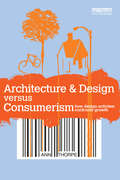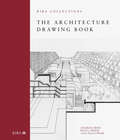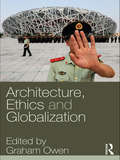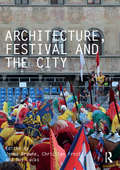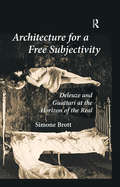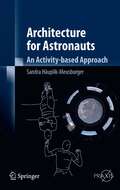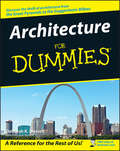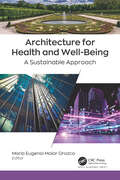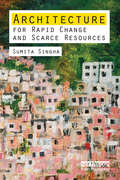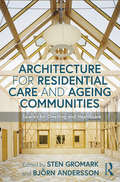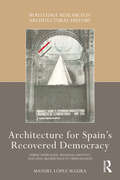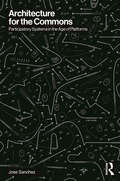- Table View
- List View
Architecture & Design versus Consumerism: How Design Activism Confronts Growth
by Ann ThorpeThe mentality that consumerism and economic growth are cure-alls is one of the biggest obstacles to real sustainability, but any change seems impossible, unthinkable. Our contemporary paradox finds us relying for our well being on consumer-driven economic growth that we actually can’t afford — not in environmental, economic or social terms. Although architecture and design have long been seen as engines for consumerism and growth, increasing numbers of designers are concerned about the problems resulting from growth. But designers face a paradox of their own; in scenarios of sustainable consumption, where people consume or build significantly less, what will be left for designers to do? This book, informed by recent research into the viability of a "steady state" economy, sets an agenda for addressing the designer’s paradox of sustainable consumption. The agenda includes ways that architecture and design can help transition us towards a new kind of economy that prioritizes real wellbeing rather than economic growth. Packed with examples and illustrations, the book argues that taking action, or activism, is an important but so far underexplored way for architects and designers to confront consumerism. The first chapters explore how economic growth and consumerism shape and are shaped by the professions of architecture, product, and landscape design and how we can understand the problem of consumerism as four main challenges that designers are already addressing. The book maps out the main issues surrounding the development of metrics that designers and others can use to measure wellbeing, instead of simply measuring economic growth. The second half of the book looks at how design activism works and its connection to growth and consumerist issues. These chapters examine how activist practices are financed, highlight five specific methods that designers use in working for social change, and investigate the power of these methods. The book concludes with a consideration of what design’s role might be in a "post-growth" society.
Architecture & Design versus Consumerism: How Design Activism Confronts Growth
by Ann ThorpeThe mentality that consumerism and economic growth are cure-alls is one of the biggest obstacles to real sustainability, but any change seems impossible, unthinkable. Our contemporary paradox finds us relying for our well being on consumer-driven economic growth that we actually can’t afford — not in environmental, economic or social terms. Although architecture and design have long been seen as engines for consumerism and growth, increasing numbers of designers are concerned about the problems resulting from growth. But designers face a paradox of their own; in scenarios of sustainable consumption, where people consume or build significantly less, what will be left for designers to do? This book, informed by recent research into the viability of a "steady state" economy, sets an agenda for addressing the designer’s paradox of sustainable consumption. The agenda includes ways that architecture and design can help transition us towards a new kind of economy that prioritizes real wellbeing rather than economic growth. Packed with examples and illustrations, the book argues that taking action, or activism, is an important but so far underexplored way for architects and designers to confront consumerism. The first chapters explore how economic growth and consumerism shape and are shaped by the professions of architecture, product, and landscape design and how we can understand the problem of consumerism as four main challenges that designers are already addressing. The book maps out the main issues surrounding the development of metrics that designers and others can use to measure wellbeing, instead of simply measuring economic growth. The second half of the book looks at how design activism works and its connection to growth and consumerist issues. These chapters examine how activist practices are financed, highlight five specific methods that designers use in working for social change, and investigate the power of these methods. The book concludes with a consideration of what design’s role might be in a "post-growth" society.
The Architecture Drawing Book: RIBA Collections
by Charles Hind Fiona Orsini Susan PughA club house in a castle in the West End of London, complete with battlements and turrets, from 1882. A design for the post-war reconstruction of the City of London in 1945. A fantasy landscape featuring Le Corbusier’s Capriccio of Notre-Dame du Haut in ruins. A section of a 19th-century townhouse, showing a slice of the staircase wallpaper winding from deep navy on the ground floor to pale sky blue at the top. This is a treasury of architectural drawing from the 16th century to the present day. Exploring both how and why architects draw, it offers a rich visual history from Palladio, Inigo Jones and Augustus Pugin to contemporaries such as Richard Rogers, Foster Associates and Zaha Hadid, via Sir Christopher Wren, George Gilbert Scott and Erno Goldfinger, and everything else in between. From back-of-envelope concept sketches to painstaking pen and ink perspectives, exploded axonometrics and born-digital drawings, this book celebrates the full gamut of architectural representation. With over 200 lush, full-colour reproductions, this is a window into soul of architectural drawing over the past five hundred years. Includes newly digitised, never-seen-before material from the RIBA Collections, one of the largest architectural archives in the world. Explores rare drawings and designs from John Nash, Sir Edwin Lutyens, Frank Lloyd Wright and many more. Insightful commentary alongside each drawing ensures that they are as accessible and engaging as possible. Wide-ranging in scope, this book will both inspire and inform.
The Architecture Drawing Book: RIBA Collections
by Charles Hind Fiona Orsini Susan PughA club house in a castle in the West End of London, complete with battlements and turrets, from 1882. A design for the post-war reconstruction of the City of London in 1945. A fantasy landscape featuring Le Corbusier’s Capriccio of Notre-Dame du Haut in ruins. A section of a 19th-century townhouse, showing a slice of the staircase wallpaper winding from deep navy on the ground floor to pale sky blue at the top. This is a treasury of architectural drawing from the 16th century to the present day. Exploring both how and why architects draw, it offers a rich visual history from Palladio, Inigo Jones and Augustus Pugin to contemporaries such as Richard Rogers, Foster Associates and Zaha Hadid, via Sir Christopher Wren, George Gilbert Scott and Erno Goldfinger, and everything else in between. From back-of-envelope concept sketches to painstaking pen and ink perspectives, exploded axonometrics and born-digital drawings, this book celebrates the full gamut of architectural representation. With over 200 lush, full-colour reproductions, this is a window into soul of architectural drawing over the past five hundred years. Includes newly digitised, never-seen-before material from the RIBA Collections, one of the largest architectural archives in the world. Explores rare drawings and designs from John Nash, Sir Edwin Lutyens, Frank Lloyd Wright and many more. Insightful commentary alongside each drawing ensures that they are as accessible and engaging as possible. Wide-ranging in scope, this book will both inspire and inform.
Architecture, Ethics and Globalization
by Graham OwenBridging the gap between architectural theory and professional practice studies, this book offers critical inquiry into the shifting ground of ethical thought in the changing climate of the global economy. Looking at issues of contemporary significance to architectural critics, practitioners, educators, and students, the book also examines the role of the architectural academy in providing an education in ethical judgement. Including transcripts of responses and discussions among its contributors, a broad interdisciplinary set of perspectives are debated and often controversial points of view are put forward.
Architecture, Ethics and Globalization
by Graham OwenBridging the gap between architectural theory and professional practice studies, this book offers critical inquiry into the shifting ground of ethical thought in the changing climate of the global economy. Looking at issues of contemporary significance to architectural critics, practitioners, educators, and students, the book also examines the role of the architectural academy in providing an education in ethical judgement. Including transcripts of responses and discussions among its contributors, a broad interdisciplinary set of perspectives are debated and often controversial points of view are put forward.
Architecture Exploration for Embedded Processors with LISA
by Andreas Hoffmann Heinrich Meyr Rainer LeupersToday more than 90% of all programmable processors are employed in embedded systems. The LISA processor design platform presented in this book addresses recent design challenges and results in highly satisfactory solutions, covering all major high-level phases of embedded processor design.
Architecture Exploration of FPGA Based Accelerators for BioInformatics Applications (Springer Series in Advanced Microelectronics #55)
by B. Sharat Varma Kolin Paul M. BalakrishnanThis book presents an evaluation methodology to design future FPGA fabrics incorporating hard embedded blocks (HEBs) to accelerate applications. This methodology will be useful for selection of blocks to be embedded into the fabric and for evaluating the performance gain that can be achieved by such an embedding. The authors illustrate the use of their methodology by studying the impact of HEBs on two important bioinformatics applications: protein docking and genome assembly. The book also explains how the respective HEBs are designed and how hardware implementation of the application is done using these HEBs. It shows that significant speedups can be achieved over pure software implementations by using such FPGA-based accelerators. The methodology presented in this book may also be used for designing HEBs for accelerating software implementations in other domains besides bioinformatics. This book will prove useful to students, researchers, and practicing engineers alike.
Architecture, Festival and the City
by Jemma Browne Christian Frost Ray LucasHistorically the urban festival served as an occasion for affirming shared convictions and identities in the life of the city. Whether religious or civic in nature, these events provided tangible expressions of social, cultural, political, and religious cohesion, often reaffirming a particular shared ethos within diverse urban landscapes. Architecture has long served as a key aspect of this process exhibiting continuity in the flux of these representations through the parading of elaborate ceremonial floats, the construction of temporary buildings, the ‘dressing’ of existing urban space, the alternative occupations of the everyday, and the construction of new buildings and spaces which then become a part of the background fabric of the city. This book examines how festivals can be used as a lens to examine the relationship between city and citizen and questions whether this is fixed through time, or has been transformed as a response to changes in the modern urban condition. Architecture, Festival and the City looks at the multilayered nature of a diverse selection of festivals and the way they incorporate both orderly (authoritative) and disorderly (subversive) components. The aim is to reveal how the civic nature of urban space is utilised through festival to represent ideas of belonging and identity. Recent political and social gatherings also raise questions about the relationship of these events to ‘ritual’ and whether traditional practices can serve as meaningful references in the twenty-first century.
Architecture, Festival and the City
by Jemma Browne Christian Frost Ray LucasHistorically the urban festival served as an occasion for affirming shared convictions and identities in the life of the city. Whether religious or civic in nature, these events provided tangible expressions of social, cultural, political, and religious cohesion, often reaffirming a particular shared ethos within diverse urban landscapes. Architecture has long served as a key aspect of this process exhibiting continuity in the flux of these representations through the parading of elaborate ceremonial floats, the construction of temporary buildings, the ‘dressing’ of existing urban space, the alternative occupations of the everyday, and the construction of new buildings and spaces which then become a part of the background fabric of the city. This book examines how festivals can be used as a lens to examine the relationship between city and citizen and questions whether this is fixed through time, or has been transformed as a response to changes in the modern urban condition. Architecture, Festival and the City looks at the multilayered nature of a diverse selection of festivals and the way they incorporate both orderly (authoritative) and disorderly (subversive) components. The aim is to reveal how the civic nature of urban space is utilised through festival to represent ideas of belonging and identity. Recent political and social gatherings also raise questions about the relationship of these events to ‘ritual’ and whether traditional practices can serve as meaningful references in the twenty-first century.
Architecture Filmmaking (PDF)
by Igea Troiani Hugh CampbellUnlike other books on architecture and film, Architecture Filmmaking investigates how the now-expanded field of architecture utilizes the practice of filmmaking (feature/short film, stop motion animation and documentary) or video/moving image in research, teaching and practice, and what the consequences of this interdisciplinary exchange are. While architecture and filmmaking have clearly distinct disciplinary outputs and filmmaking is a much younger art than architecture, the intersection between them is less defined. This book investigates the ways in which architectural researchers, teachers of architecture, their students and practising architects, filmmakers and artists are using filmmaking uniquely in their practice.
Architecture for a Free Subjectivity: Deleuze and Guattari at the Horizon of the Real
by Simone BrottArchitecture for a Free Subjectivity reformulates the French philosopher Gilles Deleuze's model of subjectivity for architecture, by surveying the prolific effects of architectural encounter, and the spaces that figure in them. For Deleuze and his Lacanian collaborator Félix Guattari, subjectivity does not refer to a person, but to the potential for and event of matter becoming subject, and the myriad ways for this to take place. By extension, this book theorizes architecture as a self-actuating or creative agency for the liberation of purely "impersonal effects." Imagine a chemical reaction, a riot in the banlieues, indeed a walk through a city. Simone Brott declares that the architectural object does not merely take part in the production of subjectivity, but that it constitutes its own. This book is to date the only attempt to develop Deleuze's philosophy of subjectivity in singularly architectural terms. Through a screening of modern and postmodern, American and European works, this provocative volume draws the reader into a close encounter with architectural interiors, film scenes, and other arrangements, while interrogating the discourses of subjectivity surrounding them, and the evacuation of the subject in the contemporary discussion. The impersonal effects of architecture radically changes the methodology, just as it reimagines architectural subjectivity for the twenty-first century.
Architecture for a Free Subjectivity: Deleuze and Guattari at the Horizon of the Real
by Simone BrottArchitecture for a Free Subjectivity reformulates the French philosopher Gilles Deleuze's model of subjectivity for architecture, by surveying the prolific effects of architectural encounter, and the spaces that figure in them. For Deleuze and his Lacanian collaborator Félix Guattari, subjectivity does not refer to a person, but to the potential for and event of matter becoming subject, and the myriad ways for this to take place. By extension, this book theorizes architecture as a self-actuating or creative agency for the liberation of purely "impersonal effects." Imagine a chemical reaction, a riot in the banlieues, indeed a walk through a city. Simone Brott declares that the architectural object does not merely take part in the production of subjectivity, but that it constitutes its own. This book is to date the only attempt to develop Deleuze's philosophy of subjectivity in singularly architectural terms. Through a screening of modern and postmodern, American and European works, this provocative volume draws the reader into a close encounter with architectural interiors, film scenes, and other arrangements, while interrogating the discourses of subjectivity surrounding them, and the evacuation of the subject in the contemporary discussion. The impersonal effects of architecture radically changes the methodology, just as it reimagines architectural subjectivity for the twenty-first century.
Architecture for Astronauts: An Activity-based Approach (Springer Praxis Books)
by Sandra Häuplik-MeusburgerLiving and working in extra-terrestrial habitats means being potentially vulnerable to very harsh environmental, social, and psychological conditions. With the stringent technical specifications for launch vehicles and transport into space, a very tight framework for the creation of habitable space is set. These constraints result in a very demanding “partnership” between the habitat and the inhabitant. This book is the result of researching the interface between people, space and objects in an extra-terrestrial environment. The evaluation of extra-terrestrial habitats in comparison to the user’s perspective leads to a new framework, comparing these buildings from the viewpoint of human activity. It can be used as reference or as conceptual framework for the purpose of evaluation. It also summarizes relevant human-related design directions. The work is addressed to architects and designers as well as engineers.
Architecture for Blockchain Applications
by Xiwei Xu Ingo Weber Mark StaplesThis book addresses what software architects and developers need to know in order to build applications based on blockchain technology, by offering an architectural view of software systems that make beneficial use of blockchains. It provides guidance on assessing the suitability of blockchain, on the roles blockchain can play in an architecture, on designing blockchain applications, and on assessing different architecture designs and tradeoffs. It also serves as a reference on blockchain design patterns and design analysis, and refers to practical examples of blockchain-based applications.The book is divided into four parts: Part I provides a general introduction to the topic and to existing blockchain platforms including Bitcoin, Ethereum, and Hyperledger Fabric, and offers examples of blockchain-based applications. Part II focuses on the functional aspects of software architecture, describing the main roles blockchain can play in an architecture, as well as its potential suitability and design process. It includes a catalogue of 15 design patterns and details how to use model-driven engineering to build blockchain-based applications. Part III covers the non-functional aspects of blockchain applications, which are cross-cutting concerns including cost, performance, security, and availability. Part IV then presents three detailed real-world use cases, offering additional insights from a practical perspective. An epilogue summarizes the book and speculates on the role blockchain and its applications can play in the future.This book focusses on the bigger picture for blockchain, covering the concepts and technical considerations in the design of blockchain-based applications. The use of mathematical formulas is limited to where they are critical. This book is primarily intended for developers, software architects and chief information officers who need to understand the basic technology, tools and methodologies to build blockchain applications. It also provides students and researchers new to this field an introduction to this hot topic.
Architecture For Dummies (For Dummies Ser.)
by Deborah K. Dietsch* Just the essential information for readers on the go who want to understand architecture. * Covers the highlights of architectural history, from the Great Pyramids to Frank Gehry's Guggenheim museum in Bilbao. * Explains how to look at a building and appreciate it. Explains when a building's a building and when it's art. * Part of Tens includes: Ten Great Architectural Masterpieces, Ten Biggest Architectural and Engineering Failures, Ten of the Most Interesting Architects Working Today-and more.
Architecture for Health and Well-Being: A Sustainable Approach
by María Eugenia Molar OrozcoThis book explores the importance of architecture designed for the well-being of users. The creation of healthy architecture involves aspects of design, materials, environmental parameters, and intended use of both outdoor and indoor spaces to facilitate a healthy environment. The book provides a unique perspective on architecture that promotes the welfare and security of those using the space, which has proved especially important during the recent COVID-19 pandemic wherein many people were confined indoors. Each chapter in the volume explains from a different angle a topic that takes into consideration how to provide benefit to human beings to achieve a better quality of life within constructions. The first part of the volume provides an overview of the role of architecture to achieve well-being. The book goes on to discuss how to adapt spaces to address urban thermal environments. The book also looks at the use of alternative materials with disinfectant characteristics, which is an important consideration during pandemics and for general health every day. The issue of affordable housing with resilient designs is also addressed as are how the use of good logistics produces healthy spaces. Key features: Describes design conditions that enhance quality of life Considers architectural design for maximizing comfort conditions in different types of climate Reviews the characteristics of materials that contribute to healthy construction Provides attractive ideas on how to create spaces in an organic way Architecture for Health and Well-Being: A Sustainable Approach helps to provide answers to the question of how can we design, plan, and sustain built environments that will foster health and healing. It provides basic information with the aim to generate change in attitudes in those who architectural designers, architectural researchers, city planners, and others.
Architecture for Health and Well-Being: A Sustainable Approach
by María Eugenia Molar OrozcoThis book explores the importance of architecture designed for the well-being of users. The creation of healthy architecture involves aspects of design, materials, environmental parameters, and intended use of both outdoor and indoor spaces to facilitate a healthy environment. The book provides a unique perspective on architecture that promotes the welfare and security of those using the space, which has proved especially important during the recent COVID-19 pandemic wherein many people were confined indoors. Each chapter in the volume explains from a different angle a topic that takes into consideration how to provide benefit to human beings to achieve a better quality of life within constructions. The first part of the volume provides an overview of the role of architecture to achieve well-being. The book goes on to discuss how to adapt spaces to address urban thermal environments. The book also looks at the use of alternative materials with disinfectant characteristics, which is an important consideration during pandemics and for general health every day. The issue of affordable housing with resilient designs is also addressed as are how the use of good logistics produces healthy spaces. Key features: Describes design conditions that enhance quality of life Considers architectural design for maximizing comfort conditions in different types of climate Reviews the characteristics of materials that contribute to healthy construction Provides attractive ideas on how to create spaces in an organic way Architecture for Health and Well-Being: A Sustainable Approach helps to provide answers to the question of how can we design, plan, and sustain built environments that will foster health and healing. It provides basic information with the aim to generate change in attitudes in those who architectural designers, architectural researchers, city planners, and others.
Architecture for Rapid Change and Scarce Resources
by Sumita SinhaArchitects, development practitioners and designers are working in a global environment and issues such as environmental and cultural sustainability matter more than ever. Past interactions and interventions between developed and developing countries have often been unequal and inappropriate. We now need to embrace fresh design practices based on respect for diversity and equality, participation and empowerment. This book explores what it means for development activists to practise architecture on a global scale, and provides a blueprint for developing architectural practices based on reciprocal working methods. The content is based on real situations - through extended field research and contacts with architecture schools and architects, as well as participating NGOs. It demonstrates that the ability to produce appropriate and sustainable design is increasingly relevant, whether in the field of disaster relief, longer-term development or wider urban contexts, both in rich countries and poor countries.
Architecture for Rapid Change and Scarce Resources
by Sumita SinhaArchitects, development practitioners and designers are working in a global environment and issues such as environmental and cultural sustainability matter more than ever. Past interactions and interventions between developed and developing countries have often been unequal and inappropriate. We now need to embrace fresh design practices based on respect for diversity and equality, participation and empowerment. This book explores what it means for development activists to practise architecture on a global scale, and provides a blueprint for developing architectural practices based on reciprocal working methods. The content is based on real situations - through extended field research and contacts with architecture schools and architects, as well as participating NGOs. It demonstrates that the ability to produce appropriate and sustainable design is increasingly relevant, whether in the field of disaster relief, longer-term development or wider urban contexts, both in rich countries and poor countries.
Architecture for Residential Care and Ageing Communities: Spaces for Dwelling and Healthcare
by Sten Gromark Bjö AnderssonArchitecture for Residential Care and Ageing Communities confronts urgent architectural design challenges within residential innovation, ageing communities and healthcare environments. The increasing and diversified demands on the housing market today call for alterability and adaptability in long term solutions for new integrated ways of residing. Meanwhile, an accentuated ageing society requires new residential ways of living, combining dignity, independence and appropriate care. Concurrently, profound changes in technical conditions for home healthcare require rethinking healing environments. This edited collection explores the dynamics between these integrated architectural and caring developments and intends to envision reconfigured environmental design patterns that can significantly enhance new forms of welfare and ultimately, an improved quality of life. This book identifies, presents, and articulates new qualities in designs, in caring processes, and healing atmospheres, thereby providing operational knowledge developed in close collaboration with academics, actors and stakeholders in architecture, design, and healthcare. This is an ideal read for those interested in health promotive situations of dwelling, ageing and caring.
Architecture for Residential Care and Ageing Communities: Spaces for Dwelling and Healthcare
by Sten Gromark; Björn AnderssonArchitecture for Residential Care and Ageing Communities confronts urgent architectural design challenges within residential innovation, ageing communities and healthcare environments. The increasing and diversified demands on the housing market today call for alterability and adaptability in long term solutions for new integrated ways of residing. Meanwhile, an accentuated ageing society requires new residential ways of living, combining dignity, independence and appropriate care. Concurrently, profound changes in technical conditions for home healthcare require rethinking healing environments. This edited collection explores the dynamics between these integrated architectural and caring developments and intends to envision reconfigured environmental design patterns that can significantly enhance new forms of welfare and ultimately, an improved quality of life. This book identifies, presents, and articulates new qualities in designs, in caring processes, and healing atmospheres, thereby providing operational knowledge developed in close collaboration with academics, actors and stakeholders in architecture, design, and healthcare. This is an ideal read for those interested in health promotive situations of dwelling, ageing and caring.
Architecture for Spain's Recovered Democracy: Public Patronage, Regional Identity, and Civic Significance in 1980s Valencia (Routledge Research in Architectural History)
by Manuel López SeguraHistorical studies on the involvement of architecture in twentieth-century politics have overlooked its contribution to building Spain’s democracy. This pioneering book seeks to fill that void. Between the late 1970s and early 1990s, Spain founded representative institutions, launched its welfare state, and devolved autonomy to its regions. The study brings forth the architectural incarnation of that threefold program as it deployed in the Valencian Country, a Catalan-speaking region on Spain’s Mediterranean shores. There, social democratic authorities mobilized architects, planners, and graphic artists to devise a newly open public sphere and to recover a local identity that Franco’s dictatorship had repressed for decades. The research follows the impetus of reform and its contradictions through urban projects, designs for cultural amenities, and the renovation of governmental and professional bodies. Architecture for Spain’s Recovered Democracy contributes to current debates on nationalism and the arts, the environments of democratic socialism, and postmodernism and neoliberalism. As a result, it widens our understanding of how peripheral regions may yield egalitarian architectures of resistance. This book is written for students and researchers in architecture and planning, art history, spatial politics, and Hispanic studies, as well as for a general readership interested in inclusive politics in the built environment.
Architecture for Spain's Recovered Democracy: Public Patronage, Regional Identity, and Civic Significance in 1980s Valencia (Routledge Research in Architectural History)
by Manuel López SeguraHistorical studies on the involvement of architecture in twentieth-century politics have overlooked its contribution to building Spain’s democracy. This pioneering book seeks to fill that void. Between the late 1970s and early 1990s, Spain founded representative institutions, launched its welfare state, and devolved autonomy to its regions. The study brings forth the architectural incarnation of that threefold program as it deployed in the Valencian Country, a Catalan-speaking region on Spain’s Mediterranean shores. There, social democratic authorities mobilized architects, planners, and graphic artists to devise a newly open public sphere and to recover a local identity that Franco’s dictatorship had repressed for decades. The research follows the impetus of reform and its contradictions through urban projects, designs for cultural amenities, and the renovation of governmental and professional bodies. Architecture for Spain’s Recovered Democracy contributes to current debates on nationalism and the arts, the environments of democratic socialism, and postmodernism and neoliberalism. As a result, it widens our understanding of how peripheral regions may yield egalitarian architectures of resistance. This book is written for students and researchers in architecture and planning, art history, spatial politics, and Hispanic studies, as well as for a general readership interested in inclusive politics in the built environment.
Architecture for the Commons: Participatory Systems in the Age of Platforms
by Jose SanchezArchitecture for the Commons dives into an analysis of how the tectonics of a building is fundamentally linked to the economic organizations that allow them to exist. By tracing the origins and promises of current technological practices in design, the book provides an alternative path, one that reconsiders the means of achieving complexity through combinatorial strategies. This move requires reconsidering serial production with crowdsourcing and user content in mind. The ideas presented will be explored through the design research developed within Plethora Project, a design practice that explores the use of video game interfaces as a mechanism for participation and user design. The research work presented throughout the book seeks to align with a larger project that is currently taking place in many different fields: The Construction of the Commons. By developing both the ideological and physical infrastructure, the project of the Commons has become an antidote to current economic practices that perpetuate inequality. The mechanisms of the production and governance of the Commons are discussed, inviting the reader to get involved and participate in the discussion. The current political and economic landscape calls for a reformulation of our current economic practices and alternative value systems that challenge the current market monopolies. This book will be of great interest not only to architects and designers studying the impact of digital technologies in the field of design but also to researchers studying novel techniques for social participation and cooperating of communities through digital networks. The book connects principles of architecture, economics and social sciences to provide alternatives to the current production trends.
